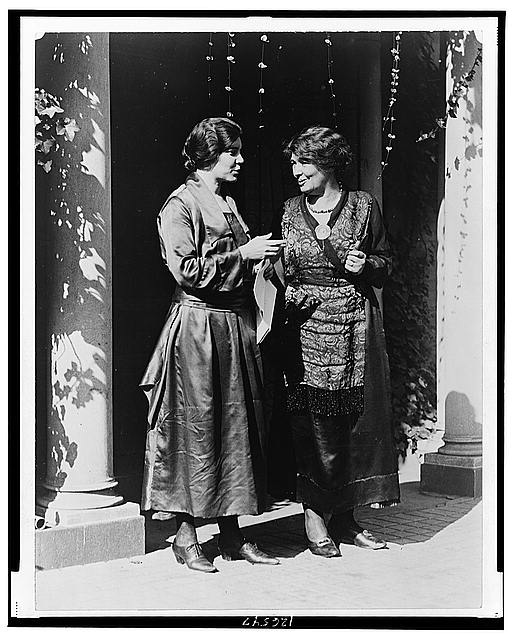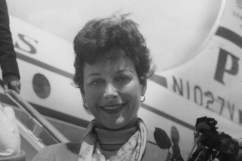
(Google)
Suffragist and women’s rights activist Alice Paul would have turned 131 on Monday, and her birthday is being celebrated with a Google Doodle.
Paul, who died in 1977 at the age of 92, was one of the leaders of the campaign for the Nineteenth Amendment to the U.S. Constitution, which was ratified in 1920 and gave women the right to vote.
She dedicated her life to securing equal rights for all women.
“Few individuals have had as much impact on American history as has Alice Paul. Her life symbolizes the long struggle for justice in the United States and around the world,” the Alice Paul Institute says. “Her vision was the ordinary notion that women and men should be equal partners in society.”
Here’s what you need to know about Alice Paul:
1. Paul Was Born in New Jersey in 1885 & Raised as a Quaker

Alice Paul in 1912. (Hulton Archive/Getty)
Alice Paul was born January 11, 1885, to Quaker parents in Mount Laurel, New Jersey, according to the Alice Paul Institute.
Paul was raised with a sense of gender equality, which was a part of the Quaker culture.
“When the Quakers were founded, one of their principles was and is equality of the sexes. So I never had any other idea, the principle was always there,” she once said.
She lived on her family’s farm and attended a Quaker school, Moorestown Friends School. After graduating at the top of her class, Paul went on to Swarthmore College, which was founded by her grandfather.
Paul earned a master’s in sociology from the University of Pennsylvania before traveling to England to continue her studies. It was there that she first became involved in woman’s suffrage, according to the biography on the Alice Paul Institute website.
She became involved with militant suffragettes led by Christabel Pankhurst, whose motto was “Deeds not words.”
Paul was imprisoned several times after committing acts of civil disobedience with the other suffragettes, including breaking windows.
She returned to America in 1910 and said about her experience in England, “The militant policy is bringing success. … the agitation has brought England out of her lethargy, and women of England are now talking of the time when they will vote, instead of the time when their children would vote, as was the custom a year or two back.”
2. She Helped Lead the 1913 Woman’s Suffrage Parade
When Paul returned from Britain, she became involved in the women’s rights movement in her home country. She launched her campaign with a massive woman’s suffrage parade in 1913, just before President Woodrow Wilson’s inauguration, according to the Sewall-Belmont Museum.
Paul formed the National Woman’s Party in 1916, focusing on a constitutional amendment that would give women the right to vote.
“But four years of rallies, lobbying, petitions, parades and election campaigns failed to budge Congress or gain the president’s support,” the museum says in an article about Paul. “On January 10, 1917, Paul led a dozen women to the gates of the White House. The first people ever to picket the White House, they called themselves ‘Silent Sentinels'”
They carried signs and banners that asked questions like, “Mr. President how long must women wait for liberty?” and “Mr. President what will you do for woman suffrage?”
3. She Was Jailed for Protesting Outside the White House & Went on a Hunger Strike

(Library of Congress)
Paul and her colleagues in the National Woman’s Party and other women’s rights groups continued to picket outside of the White House in 1917, but some saw them as disloyal after World War I began.
Picketers were arrested on charges of “obstructing traffic” and jailed when they refused to pay fines, according to the Alice Paul Institute.
The suffragists continued to protest despite the arrests. Paul was eventually arrested herself and sentenced to seven months in jail.
Paul began her sentence on October 20, 1917, and she went on a hunger strike to protest the terrible conditions she and other prisoners were kept in. The Alice Paul Institute explains:
The arrested suffragists were sent to Occoquan Workhouse, a prison in Virginia. Paul and her compatriots followed the English suffragette model and demanded to be treated as political prisoners and staged hunger strikes. Their demands were met with brutality as suffragists, including frail, older women, were beaten, pushed and thrown into cold, unsanitary, and rat-infested cells. Arrests continued and conditions at the prison deteriorated. For staging hunger strikes, Paul and several other suffragists were forcibly fed in a tortuous method. Prison officials removed Paul to a sanitarium in hopes of getting her declared insane. When news of the prison conditions and hunger strikes became known, the press, some politicians, and the public began demanding the women’s release.
By November 28, all the women were released from jail. In January 1918, Woodrow Wilson announced his support for woman’s suffrage and in 1920, the Nineteenth Amendment was ratified.
4. She Fought to Get Protection for Women Into the 1964 Civil Rights Act

Alice Paul with Emmeline Pethick-Lawrence, a British women’s rights activist. (Library of Congress)
Paul continued to fight for women’s rights after the amendment victory.
“It is incredible to me that any woman should consider the fight for full equality won. It has just begun. There is hardly a field, economic or political, in which the natural and unaccustomed policy is not to ignore women…Unless women are prepared to fight politically they must be content to be ignored politically,” Paul said in 1920.
“There is danger that because of a great victory women will believe their whole struggle for independence ended. They have still far to go,” Paul said in The Suffragist in 1921. “It is for the Woman’s Party to decide whether there is any way in which it can serve in the struggle which lies ahead to remove the remaining forms of woman’s subordination”
In 1964, Alice Paul fought to include a prohibition on sex discrimination in the Civil Rights Act.
5. She Died 3 years After Suffering a Devastating Stroke in 1974
Paul suffered a stroke in 1974 and died three years late, on July 9, 1977, at the age of 92 at her home in New Jersey.
After her death, Paul was inducted into the National Women’s Hall of Fame. Swathmore College named a dormitory and Women Center after her. She was honored with stamps in both the United States and Great Britain.
The Alice Paul Institute was founded in 1990 in her family’s farmhouse, Paulsdale, in her hometown of Mount Laurel, to preserve her legacy. It has been recognized as a National Historic Landmark.
A 2004 movie, Iron Jawed Angels, told the story of Paul’s role in the suffrage movement. She was played by Hilary Swank. You can watch a clip from the film above.



